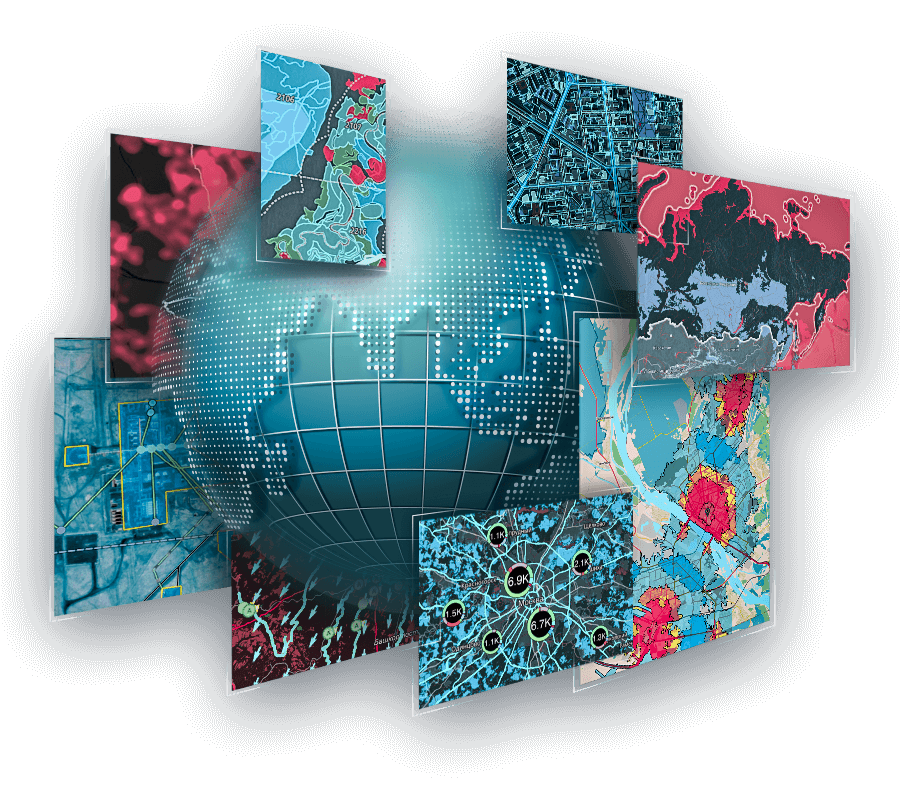Геоинформационная платформа CoGIS полностью независима от проприетарного зарубежного программного обеспечения, поддерживает интеграцию с отечественными информационными системами и прекрасно подходит для внедрения геоинформационных технологий в организации с особыми ограничениями на использование зарубежного ПО. Возможна интеграция с системами аутентификации ЕСИА (Госуслуги) и ВКонтакте.
CoGIS поддерживает работу в таких отечественных ОС, как Astra Linux, РЕД ОС, SberLinux, Alt Linux, РОСА, Атлант и др., а также Ubuntu, Debian, CentOS.
CoGIS поддерживает работу с отечественными СУБД: Postgres Pro, Platform V Pangolin DB и др., а также PostgreSQL.
Компоненты платформы
Платформа CoGIS является модульной и состоит из нескольких компонент, отвечающих за свой функциональный блок:
- Конструктор картографических приложений - Создание полноценных картографических веб-приложений на основе картографических сервисов, инструментов геообработки и анализа, настройка структуры и содержания геопортала, не требующее навыков программирования.
- ГИС-сервер - Публикация картографических векторных и растровых данных и инструментов геообработки в виде веб-сервисов.
- Геопортал - Единая точка доступа пользователей к опубликованным интерактивным картам, картографическим веб-приложениям, веб-страницам, документам, ссылкам на внешние источники.
- Мобильные приложения - Работа с опубликованными офлайн- и онлайн-картами на мобильных устройствах Android и iOS, с помощью мобильной верстки веб-портала и удобных мобильных приложений.
Создание картографических приложений без программирования
Отличительной особенностью платформы CoGIS является возможность создания тематических картографических веб-приложений, не прибегая к классическому программированию.
Работа с Конструктором приложений не требует никаких специальных технических навыков и знания языков программирования. Благодаря дружественному интерфейсу Конструктора вы без привлечения программистов сможете задать структуру, содержимое и функции вашего геопортала, а также отрегулировать доступ к данным в соответствие с правами пользователей и настроить автоматические реакции на события в системе, например удаление, добавление или изменение данных.
Кроме того, CoGIS предлагает целый ряд готовых инструментов геообработки, при помощи которых вы сможете создавать модели геообработки (визуальное представление рабочего процесса, где последовательно запускаются несколько инструментов). Это позволит существенно расширить функциональные возможности вашего геопортала и автоматизировать работу.
Высокая производительность и стабильность
Входящий в состав платформы CoGIS ГИС-сервер имеет высокую производительность отрисовки карты, что особенно важно для публикации насыщенных динамических данных. За счёт отличной оптимизации использования ресурсов ГИС-сервер позволяет публиковать сотни сервисов на одном сервере.
ГИС-сервер поддерживает быстрое построение тайлового кэша по заданным масштабам и областям (включая определение экстентов через полигональный слой), создание тайлов на лету, а также возможность обновления тайлового кэша при изменении данных.
Кроме того, ГИС-сервер предлагает и другие возможности визуализации геоданных, например кластеризация объектов, построение тепловых карт, обрезка изображения по зоне допуска и т. д.
Настраиваемый режим изоляции сервисов позволяет повысить общую стабильность ГИС-сервера и обеспечить бесперебойную работу всей инфраструктуры.
Платформа CoGIS может применяться для решения задач в разных отраслях:
- кадастр и управление земельными ресурсами;
- геология и добыча полезных ископаемых;
- управление производством и предприятием;
- управление городом и жилищно-коммунальным хозяйством;
- бережливое недропользование, анализ и мониторинг чрезвычайных ситуаций;
- научно-образовательная деятельность;
- нефтегазодобывающая промышленность и другие.
Как создаются приложения
Геоданные могут храниться в СУБД, таких как PostgreSQL, Microsoft SQL Server и др. Перед публикацией геоданные необходимо подготовить - задать стиль отрисовки, задать подписи, подключить справочники для атрибутов и пр. Кроме того, для публикации можно использовать и готовые карты в форматах KML/KMZ, CMF2, а также данные в формате GeoPackage или шейп-файлы.
Следующий этап — это публикация подготовленных картографических проектов в виде веб-сервисов и создание на базе опубликованных веб-сервисов картографических приложений. ГИС-сервер поддерживает стандарты OGC и AGS.
Готовые опубликованные карты представлены в виде иерархичного каталога и доступны как на веб-портале CoGIS, так и в мобильном приложении CoGIS Mobile.
Поможем, покажем, проконсультируем
Если вы заинтересовались нашей платформой или у вас появились вопросы, напишите нам по адресу support@dataeast.ru, мы будем рады помочь.
В удобное для вас время мы можем провести демонстрацию возможностей CoGIS, чтобы вы могли оценить, насколько эта платформа может быть полезна для решения ваших задач.
Кроме того, мы рекомендуем посетить наш демонстрационный портал, где опубликован каталог тематических карт, с помощью которых вы сможете самостоятельно ознакомиться со множеством функций и инструментов CoGIS.
Платформа CoGIS разработана на базе фреймворка .NET 8.0 и может быть установлена на множестве операционных систем, таких как: Astra Linux, РЕД ОС, SberLinux OS Server, Alt Server, РОСА Сервер, Атлант, Ubuntu, Debian, CentOS, RHEL и др.), Windows Server.
CoGIS построена по микросервисной архитектуре, поэтому для её работы требуется один из веб-серверов: NGINX, Apache, IIS. Если у вас уже есть веб-сервер, то он может выступить в роли API Gateway / Application Gateway для сервисов платформы.
CoGIS поддерживает подключение к таким СУБД, как: PostgreSQL (PostGIS), Postgres Pro (PostGIS), Platform V Pangolin DB, Microsoft SQL Server.

